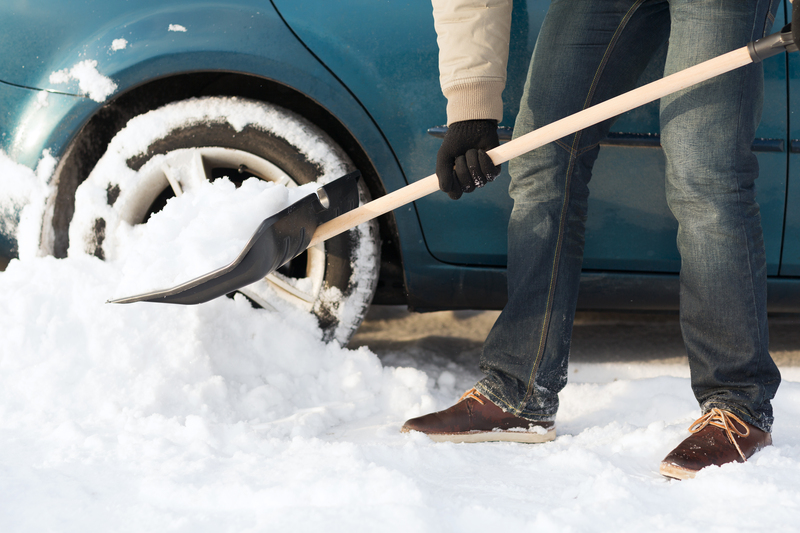Learn How to Store Your Freezer Like a Pro
Posted on 17/05/2025
Learn How to Store Your Freezer Like a Pro: The Ultimate Guide
If you've ever opened your freezer only to find mysterious, frost-covered packages or unidentifiable leftovers, it's time to step up your game. Proper freezer organization and food storage are not only crucial to reducing food waste and saving money, but they also ensure food safety and convenience. In this comprehensive article, you'll discover expert strategies, creative solutions, and easy tips to help you store your freezer like a pro. Say goodbye to freezer burn and cluttered shelves--let's unlock the secrets of efficient freezer storage together!

Why Proper Freezer Storage Matters
Before diving into the how-tos, it's vital to understand why learning to store your freezer like a pro is important. Here's why mastering the best freezer storage practices will make a difference in your home:
- Minimize Food Waste: Well-organized freezers help you see what you have and avoid buying duplicates.
- Preserve Food Quality: Correct storage methods maintain taste, texture, and nutritional content.
- Save Money: Maximizing your freezer's capacity and minimizing spoilage saves dollars.
- Ensure Food Safety: Proper freezing prevents bacterial growth and contamination.
- Save Time and Stress: Easily find what you need, reducing time spent rummaging.
Getting Started: Clean and Prep Your Freezer
Before you can organize your freezer like a pro, start with a clean slate:
- Unplug your freezer or switch to "defrost" mode if possible.
- Remove all items, tossing anything unidentifiable or clearly past its prime.
- Wash all surfaces with a solution of warm water and baking soda (2 tablespoons per quart) to remove odors and stains.
- Dry thoroughly before plugging the freezer back in to prevent ice build-up.
What Foods Freeze Best? Choosing Freezer-Friendly Staples
Certain foods are ideal for freezing, while others don't fare as well. To maximize your freezer's potential, focus on stocking it with these:
- Proteins: Beef, chicken, pork, fish, and seafood all freeze well for up to 6-12 months.
- Vegetables: Most can be frozen, but blanch (quick-cook in boiling water) first to preserve color and texture.
- Fruits: Berries, peaches, bananas, and pineapples are freezer stars. Slice and freeze on a tray before bagging.
- Bread and Baked Goods: Freeze loaves, rolls, muffins, and cookie dough for easy baked treats.
- Prepared Meals: Lasagnas, soups, casseroles, and stews make fast weeknight dinners.
- Herbs: Chop and freeze in olive oil or water using ice cube trays for instant flavor boosts.
Avoid Freezing These Items
- Lettuce, cucumbers, and watery vegetables--they turn mushy.
- Soft cheeses--can separate and become grainy.
- Fried foods--they lose their crispy texture.
- Cream-based sauces--they often split or curdle.
Freezer Storage Containers: What to Use and What to Skip
Your choice of containers can make all the difference! For professional-grade freezer organization, choose wisely:
Best Options for Freezer Storage
- Freezer-Safe Zip-Top Bags: Press out air for space-saving and reduce freezer burn.
- Airtight Food Storage Containers: Durable plastic or glass with ample seals for liquids and leftovers.
- Vacuum-Seal Bags: Ideal for meat, produce, and meal prep to extend shelf life.
- Aluminum Foil and Heavy-Duty Freezer Wrap: Good for wrapping cakes, bread, and large portions.
- Freezer Labels and Markers: Essential for tracking dates and contents.
Avoid These Common Mistakes
- Using thin plastic bags like sandwich bags--they allow freezer burn.
- Reusing containers that aren't freezer-safe--they can crack or warp.
- Skipping labels--you'll end up with mystery meals!
Pro Techniques for Packing Your Freezer Efficiently
To truly store your freezer like a pro, follow these smart packing strategies:
- Freeze in Flat Layers: Lay bags flat when freezing soups, sauces, or chopped meats. Once solid, stand them upright like books to save space.
- Portion Control: Divide large packages into meal-sized portions before freezing to avoid thawing more than you need.
- Use Freezer Bins and Baskets: Sort by category--meats, veggies, prepared meals--for easy access.
- Label Everything: Include name, date frozen, and any reheating instructions for total clarity.
- First In, First Out (FIFO): Place new items at the back and older items at the front so nothing gets forgotten.
Preventing Freezer Burn: Expert Tips
Freezer burn happens when air comes into contact with food, dehydrating and damaging its quality. Here's how to keep your food at its best:
- Use Airtight Packaging: Always remove as much air as possible before sealing bags or containers.
- Don't Overfill or Underfill: Too much air in containers leads to freezer burn; too little can cause containers to burst.
- Wrap Items Well: Wrap tightly in plastic wrap, then foil for an extra barrier.
- Keep Freezer Temperature Consistent: Stay at 0?F (-18?C) for optimal storage.
- Seal with Date and Name: Always know what's inside and when it's at its best.
Organizing Your Freezer Like a Pro: Step-by-Step System
Ready to take your organization to the next level? Here's a systematic approach to organizing your freezer like a true professional:
Step 1: Create Freezer Zones
- Divide your freezer into sections for proteins, vegetables/fruits, baked goods, and ready-to-eat meals.
- Assign baskets or bins for each group.
Step 2: Use Vertical Storage
- Store flat bags and thin packages upright to maximize space and visibility.
- Use magazine holders or file organizers to keep things tidy.
Step 3: Utilize Door Space
- Use this for frequently accessed items or small packages (herbs, frozen juice, nuts).
- Avoid storing highly perishable foods in the door--it's warmer and less consistent.
Step 4: Add a Freezer Inventory List
- Place a magnetic whiteboard or notepad on the freezer for tracking what's inside.
- Update as you add or remove items to avoid surprises.
Freezer Storage Times: How Long Can You Keep It?
Food can last months in the freezer, but it doesn't last forever. Be sure to learn how long to store foods to keep everything safe and tasty:
- Raw meats (beef, chicken, pork): 6-12 months
- Cooked meats and casseroles: 2-3 months
- Fish and seafood: 3-6 months
- Bread and baked goods: 2-3 months
- Vegetables: 8-12 months
- Fruits: 8-12 months
Note: While food may stay safe indefinitely at 0?F, quality and flavor decline over time. Always check for off smells, textures, or colors.
Defrosting Freezer Items Safely
A key part of storing your freezer like a pro is knowing how to thaw items safely and quickly:
- Overnight in the Refrigerator: Safest method for meats and prepared meals.
- Quick-Thaw in Cold Water: Submerge sealed bag in cold water, changing water every 30 minutes.
- Microwave: For last-minute needs, use your microwave's "defrost" setting--then cook immediately.
Bonus Tips: Pro Secrets for Freezing and Organizing
- Freeze individual portions: Great for single servings and faster thawing.
- Pre-chop fruits/veggies: Save prep time for smoothies, stews, and stir-fry.
- Leave room for expansion: Liquids and wet foods expand as they freeze--avoid overfilling containers.
- Group similar items: It simplifies meal planning and reduces wasted time searching.
- Rotate your stash: Place new items at the back to use older food first.
- Take advantage of freezer baskets: Use stackable baskets to separate breakfast, lunch, and dinner supplies.
- Freeze food at peak freshness: Freezing later leads to loss of nutrients and flavor.
Freezer Organization Ideas
- Use clear bins: Instantly see what's inside without digging.
- Try a binder clip hack: Clip bags to wire freezer shelves to hang veggies upright.
- DIY "Eat First" basket: Place items nearing their use-by date here for quick selection.
- Stack vertically: Make the most of deep freezers by stacking boxes, pizzas, and pancakes upright.
- Label with color codes: Use colored tape for proteins, veggies, sweets, and meal prep.

Frequently Asked Questions about Freezer Storage
What is the best temperature for freezer storage?
The ideal freezer temperature is 0?F (-18?C) or lower. Keep a thermometer inside for best accuracy.
Can I refreeze thawed food?
It's generally safe if it was thawed in the refrigerator and not left at room temperature for more than 2 hours. Quality may be affected.
How do I prevent smells in my freezer?
Use an open box of baking soda, keep sealed containers, and regularly clean with a baking soda solution.
Why does my freezer get frosty?
Frequent opening and closing or unwrapped food can let moisture in, causing ice buildup. Defrost regularly if your freezer is manual-defrost.
Do I need to rotate food?
Yes! Always practice FIFO ("First In, First Out") to use older items before new additions and minimize waste.
Conclusion: Become a Freezer Storage Pro Today!
Learning how to store your freezer like a pro isn't just about making things look nice. It's a savvy, money-saving, and safety-conscious habit that pays off every day. From choosing the right containers and labeling your food to organizing in strategic zones and maximizing every inch, you'll transform your freezer from chaotic to chef-worthy.
Start today by cleaning out your freezer, adopting some expert tips, and making your weekly meals simpler, safer, and more delicious. So go ahead--master the art of freezer storage and enjoy the benefits of a perfectly organized, always-ready freezer for years to come!






